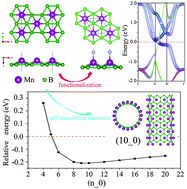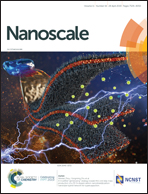MnB2 nanosheet and nanotube: stability, electronic structures, novel functionalization and application for Li-ion batteries†
Abstract
In this paper, two kinds of two-dimensional manganese boride monolayers, h-MnB2 and t-MnB2, are predicted to be stable metallic nanosheets, which exhibit favorable mechanical and thermal properties. The Young's moduli of h-MnB2 and t-MnB2 are 77.73 N m−1 and 59.59 N m−1, respectively. Ab initio molecular dynamics results show that h-MnB2 and t-MnB2 can sustain up to 500 K and 1000 K, respectively. The magnetic property of h-MnB2 is frustrated antiferromagnetic with a Néel temperature of about 25 K, and the magnetic property of t-MnB2 is collinear antiferromagnetic with a Néel temperature of about 317 K. In addition, the electronic structure of the h-MnB2 monolayer can be tuned by passivation to exhibit Dirac states. h-MnB2 can also self-assemble to form nanotubes, and is thus very promising for application as the anode for Li-ion batteries because of its high capacity (about 875 mA h g−1), low diffusion barrier (about 0.03 eV) and strong stability.



 Please wait while we load your content...
Please wait while we load your content...